By Guy Collins
As the 2019 cotton planting season approaches, we know that it is especially important to frequently monitor and evaluate planting conditions once we get into our planting window. Prevailing temperatures (day and night) during the 5-day period following cotton planting, along with the potential for intense rains, are by far the best predictor for planting success in establishing acceptable plant stands. Additionally, some scenarios often influence our planting practices so that adjustments can be made during periods of less-than-ideal conditions in order to optimize stand establishment and early season vigor.
As discussed during winter meetings, we worked with the NC Climate Office beginning in late July of 2018 and recently launched the NCSU Cotton Planting Conditions Calculator in January. This new online tool can be found on the left-side toolbar on the
NCSU Cotton Portal website as illustrated below:

This new online tool will modernize and simplify the process for cotton producers to monitor forecasted planting conditions and NCSU recommendations for cotton planting. The NCSU Cotton Planting Conditions Calculator utilizes National Weather Service data and weather forecasts to calculate a 5-day predicted DD-60 forecast for the current day and the following 2 days at any given time the calculator is used. We understand how fickle the weather can be during the spring, and that forecasts often drastically and frequently change within a day. This real-time online tool will reflect any sudden changes in weather forecasts. Producers should utilize this calculator multiple times a day during planting season to see how changes in weather forecast may affect our recommendations and ratings for planting cotton. This calculator is very quick and easy to use, requiring very little time to make planting decisions or adjustments to planting practices necessary to optimize success of establishing adequate stands. All a producer needs to do is select a location on the map and click on “submit”. The calculator utilizes a Google Earth platform so that growers can zoom in and select particular fields on their farm in order to attain the most precise and geographically relevant forecast that is suited to their farm, as illustrated in the screenshots below.
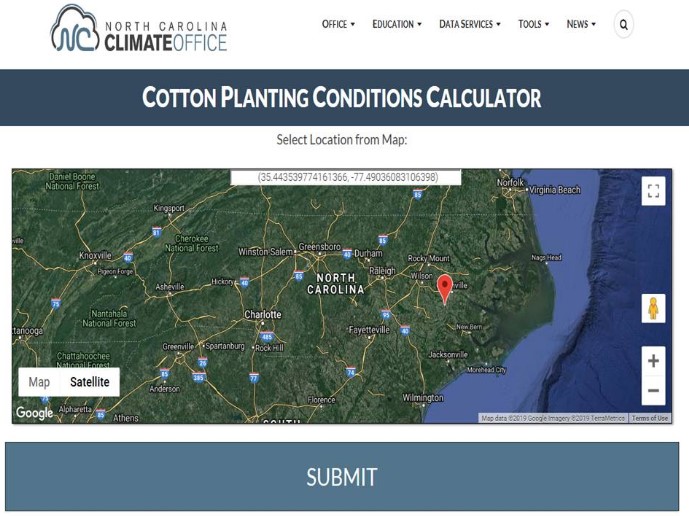
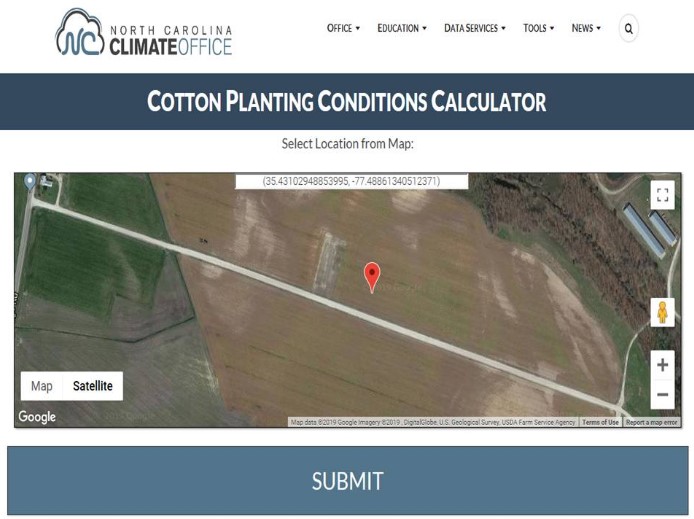
Once a field is selected, the user simply should click on “submit”, and planting condition forecasts and recommendations for that that precise location will appear. The color-coded rating for each of the three 5-day DD-60 predicted forecasts corresponds to following rating chart, which can be found at the bottom of the page.
The following are examples of the results a grower might observe when using the calculator. Again, the color scheme in the results correspond to the chart shown above. Ideally, once our planting window arrives, we would like to see the planting forecast to be rated similarly to Example 1. Obviously, we want to plant cotton when conditions are most suitable, and in cases such as this, weather conditions are ideal for planting cotton, therefore the calculator will not likely generate many warnings. However, in most years in NC, we often experience less-than-ideal conditions at some point during our planting window as illustrated in Examples 2 & 3.
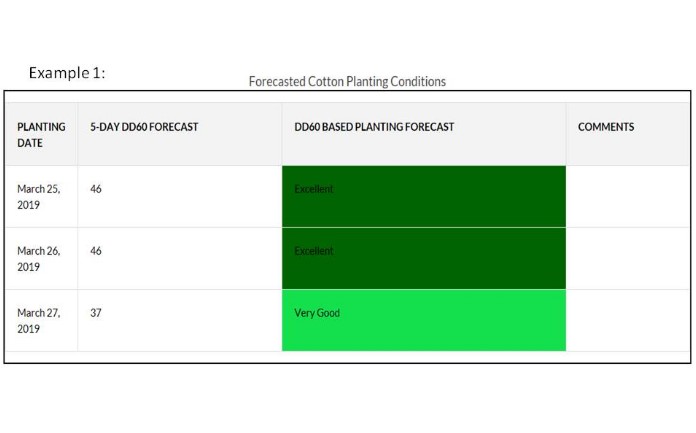
In the following examples, conditions may not be ideal for cotton planting, but success may be achieved if certain precautions are taken. If conditions are rated as “adequate” or “marginal”, the calculator will generate a comment suggesting that producers should wait on better conditions, avoid planting in cool wet soils that are prone to crusting, or plant larger seeded varieties with the highest cool germ percentages, planting shallower, hill-dropping, or increasing seed rate.
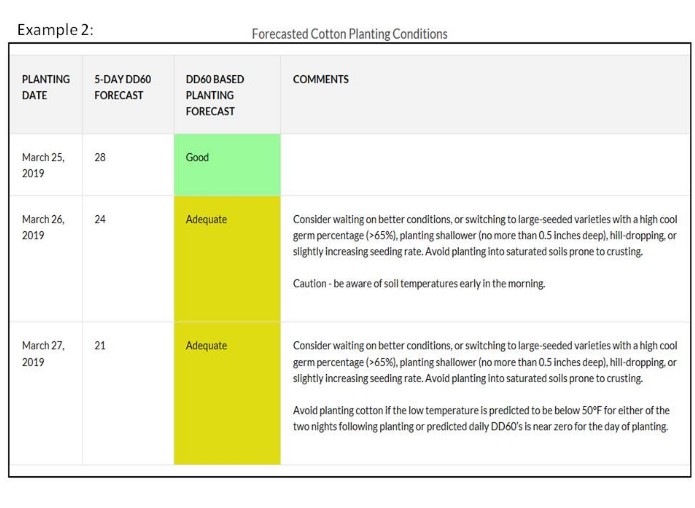
In scenarios where nighttime low temperatures fall below 50ºF within the first few days of planting, significant risks to cotton seed are likely to occur, therefore the calculator will generate a warning telling the user to avoid planting until better conditions arrive. When nighttime low temperatures fall between 50ºF and 55ºF, the calculator will generate a warning to caution growers to be aware of early morning soil temperatures. Although not illustrated in these examples, we often lose cotton stands to intense rainfall that occurs within the first few days of planting. Regardless of the rating, the calculator will generate a rainfall warning in cases where there is a 30% chance or more of accumulating 1 inch of rain or more.
The above screenshots are better suited when using a computer to access the calculator. However, slightly below this display is an accordion-style display which is more appropriate for those using a smart-phone to access the calculator, as illustrated below.
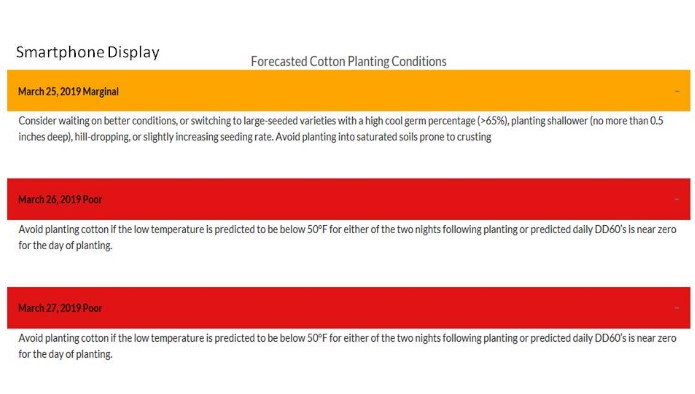
We hope that this new calculator is widely adopted and used by growers, as significant time and effort has been devoted to this project. We still intend on providing a series of newsletters during and throughout the planting window, however this new calculator should help producers fine-tune planting decisions by providing a more timely, precise, and geographically relevant platform for which to make these critical decisions. Again, the calculator can be accessed on the
NCSU Cotton Portal website or directly at
http://climate.ncsu.edu/cotton_planting.
When using the calculator, growers should make sure they plant cotton within the normally recommended planting window (late April through May 25th in North Carolina), regardless of forecasted conditions. Even though planting conditions may appear to be suitable well before our recommended planting window begins, growers should not plant too early for a number of reasons, primarily due to the chances of recurring cool spells beyond what the forecast can predict.
Lastly, your local county agents are experts on using this calculator and can be used as a local resource to provide this information to you.